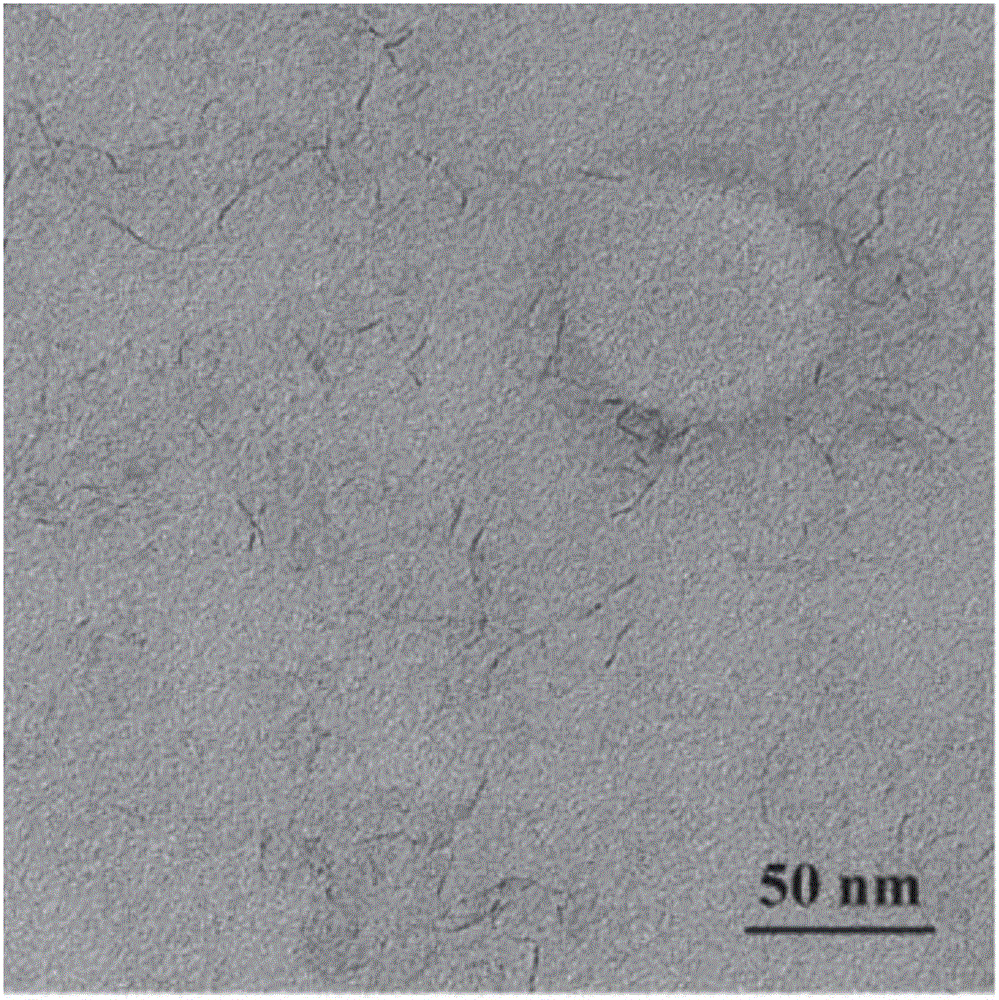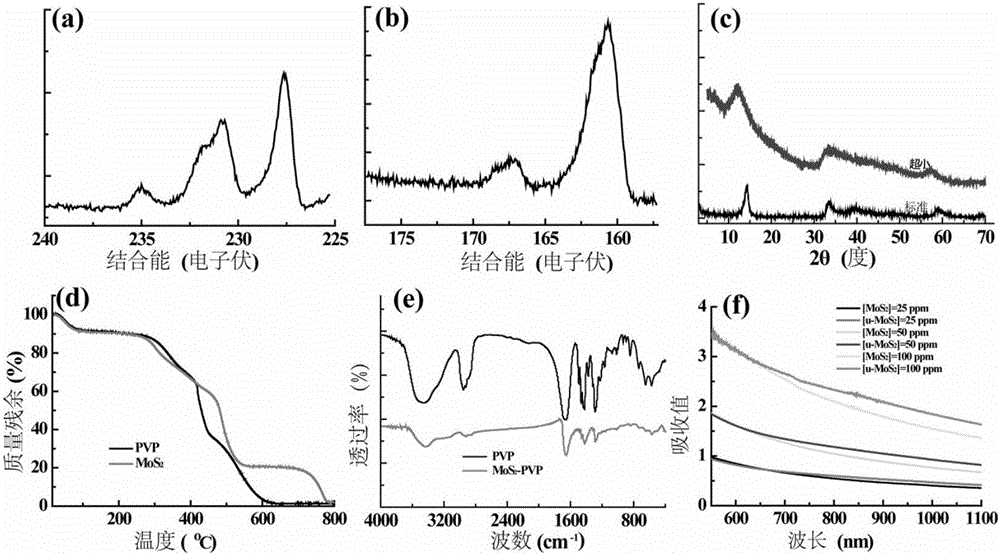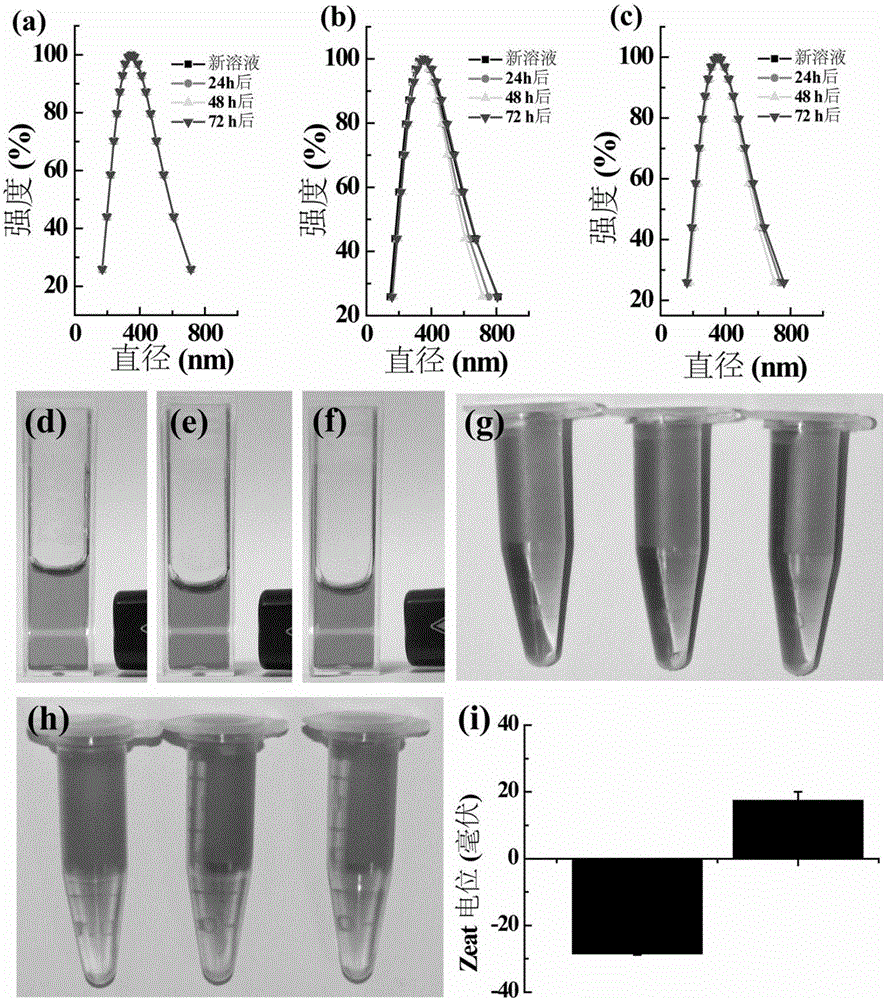Ultra-small MoS2 nanosheet as well as preparation method and application thereof
A nanosheet, molybdenum source technology, applied in nanotechnology, pharmaceutical formulations, echo/ultrasonic imaging agents, etc., can solve problems such as poor tumor effect, achieve excellent colloidal stability, efficient preparation method, and reduce non-specific phagocytosis. Effect
- Summary
- Abstract
- Description
- Claims
- Application Information
AI Technical Summary
Problems solved by technology
Method used
Image
Examples
Embodiment 1
[0029] Weigh 0.15g of PVP (molecular weight: 30kDa), mix with 30 mL of distilled water, and stir at room temperature for 1 hour to obtain a clear and transparent solution. Weigh 0.15 g of ammonium tetrathiomolybdate, mix it with the above PVP solution, and continue stirring at room temperature for 1 h to obtain a clear and transparent solution. The resulting solution was transferred to a 100 mL volume stainless steel reaction kettle lined with p-polyphenylene and sealed. The reactor was placed in a high-temperature oven for heat treatment at 220 °C for 12 h, and after cooling to room temperature naturally, the reaction mixture was centrifuged and washed five times with 50% ethanolamine solution and distilled water to obtain ultra-small MoS 2 Nanosheets. Observe the microscopic morphology of the material by TEM: Disperse an appropriate amount of nanosheets in absolute ethanol, and after ultrasonically dispersing evenly, immerse the copper mesh coated with carbon film in the ab...
Embodiment 2
[0032] The valences of Mo and S elements in the nanosheets were characterized by ESCAlab250 X-ray photoelectron spectrometer (XPS) from Thermal Scientific Company. The excitation source is monochromator Al Kα X-rays (λ = 0.8339 nm), the energy is 1486 eV, the line width is 0.9 eV, and the power is 150 W. The binding energy was corrected with the 1s peak of C (284.8 eV). The crystal structure of the XRD diffraction pattern of the nanosheets was investigated using XRD (Rigaku D / max-2200PC, Japan). With Cu2Kα rays as the light source, the operating voltage is 40 kV, the current is 200 mA, and the scanning angle (2θ) ranges from 3° to 70°. Using FTIR (Nicolet Nexus 670 infrared spectrometer) and UV-Vis-NIR (Lambda 25, Perkin Elmer Company, USA) to study ultra-small MoS 2 Nanosheet characterization. For FTIR characterization, take a few ultra-small MoS 2 Nanosheet powder and PVP powder (control group), mixed with dry KBr powder, ground evenly and then pressed into tablets. Pla...
Embodiment 3
[0036] Ultra-small MoS 2 Nanosheets and ordinary MoS 2 The nanosheets were dispersed in the wells of a 96-well cell culture plate to obtain suspensions with different Mo concentrations (e.g. Figure 4 shown), distilled water was used as a control. use as Figure 4 Ultra-small MoS irradiated with near-infrared laser light of 808nm wavelength with preset power listed 2 Nanosheets, ordinary MoS 2 Nanosheet dispersion or distilled water, the temperature change of the material dispersion or distilled water over time and the corresponding infrared thermal imaging photos are recorded by the FLIR E60 thermal imaging camera.
[0037] From Figure 4 It can be seen that the ultra-small MoS 2 Nanosheets and ordinary MoS 2 Nanosheets show different thermal conversion capabilities. High concentration of MoS 2 Nanosheets can more effectively convert light to heat to increase water temperature ( Figure 4 (a,b)). At the same material concentration, the higher the applied laser dens...
PUM
 Login to View More
Login to View More Abstract
Description
Claims
Application Information
 Login to View More
Login to View More - R&D
- Intellectual Property
- Life Sciences
- Materials
- Tech Scout
- Unparalleled Data Quality
- Higher Quality Content
- 60% Fewer Hallucinations
Browse by: Latest US Patents, China's latest patents, Technical Efficacy Thesaurus, Application Domain, Technology Topic, Popular Technical Reports.
© 2025 PatSnap. All rights reserved.Legal|Privacy policy|Modern Slavery Act Transparency Statement|Sitemap|About US| Contact US: help@patsnap.com



